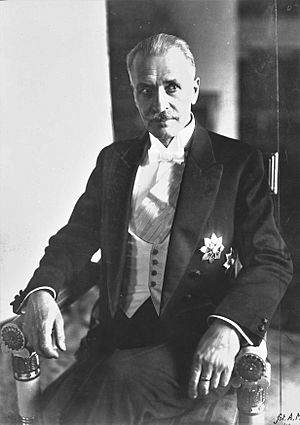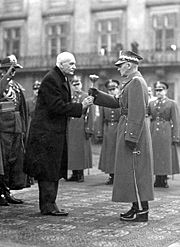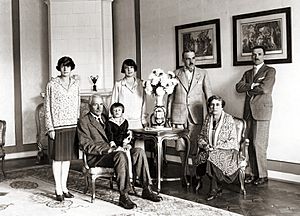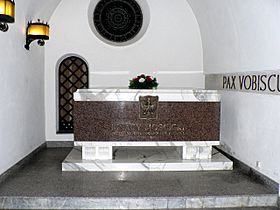Ignacy Mościcki facts for kids
Quick facts for kids
Ignacy Mościcki
OOB OPR
|
|
|---|---|

Mościcki c. 1930s
|
|
| 3rd President of Poland | |
| In office 4 June 1926 – 30 September 1939 |
|
| Prime Minister | Kazimierz Bartel Józef Piłsudski Kazimierz Bartel Kazimierz Świtalski Kazimierz Bartel Walery Sławek Józef Piłsudski Walery Sławek Aleksander Prystor Janusz Jędrzejewicz Leon Kozłowski Walery Sławek Marian Zyndram-Kościałkowski Felicjan Sławoj Składkowski |
| Preceded by | Stanisław Wojciechowski |
| Succeeded by | Władysław Raczkiewicz (in exile) Bolesław Bierut (in Poland) |
| Personal details | |
| Born | 1 December 1867 Mierzanowo, Congress Poland, Russian Empire |
| Died | 2 October 1946 (aged 78) Versoix, Switzerland |
| Resting place | St. John's Archcathedral, Warsaw |
| Political party | Proletariat (until 1892) |
| Spouses | Michalina Czyżewska Maria Dobrzańska
(m. 1933) |
| Children | 4 |
| Profession |
|
| Signature | |
Ignacy Mościcki (born December 1, 1867 – died October 2, 1946) was an important Polish chemist and politician. He served as the country's president from 1926 to 1939. He was the longest-serving president in Poland's history. Mościcki was the President of Poland when Germany invaded the country on September 1, 1939. This invasion marked the beginning of World War II.
Contents
Early Life and His Work
Ignacy Mościcki was born on December 1, 1867. His birthplace was Mierzanowo, a small village in what was then Congress Poland. After finishing school in Warsaw, he decided to study chemistry. He attended the Riga Polytechnicum university. While there, he joined a secret Polish group called Proletariat.
After he graduated, Mościcki went back to Warsaw. However, the secret police of the Russian Empire threatened him. To avoid being sent away to Siberia, he had to leave Poland in 1892. He moved to London. In 1896, he got a job at the University of Fribourg in Switzerland. Here, he invented a new, cheaper way to make nitric acid for industries.
In 1912, Mościcki moved to Lviv. This city was then part of Austria-Hungary. He became a professor at the Lviv Polytechnic university. He taught physical chemistry and electrochemistry. In 1925, he was chosen to be the head of the Lwów Polytechnic. Soon after, he moved to Warsaw to continue his research at the Warsaw Polytechnic. In 1926, he became an honorary member of the Polish Chemical Society.
Becoming President of Poland

In 1926, a big change happened in Poland. Józef Piłsudski, a famous Polish leader, led a coup d'état (a sudden takeover of government). After this, on June 1, 1926, Mościcki was chosen as the new President of Poland. Piłsudski himself had been offered the job but turned it down. He suggested Mościcki for the role. Mościcki and Piłsudski had known each other for a long time.
As president, Mościcki worked closely with Piłsudski. He always supported Piłsudski's decisions. He never disagreed with the Marshal's leadership. After Piłsudski died in 1935, his supporters had different ideas about who should lead next. Some supported Mościcki. Others supported General Edward Rydz-Śmigły. And some supported Prime Minister Walery Sławek.
To make sure Sławek didn't become too powerful, Mościcki made a deal with Rydz-Śmigły. They agreed to share power. This made Sławek less important in politics. Because of this agreement, Rydz-Śmigły became the main leader of Poland. Mościcki stayed important by continuing his role as president.
Mościcki was seen as a calm and moderate leader. The government at that time was sometimes called the "colonels' government." This was because many military officers were in important government jobs. Mościcki did not agree with some of the extreme nationalist ideas of Rydz-Śmigły. However, their agreement to work together mostly stayed strong.
Mościcki remained president until September 1939. This was when Germany invaded Poland. He was then held in Romania. France asked him to step down from his role. He passed his presidential duties to General Bolesław Wieniawa-Długoszowski. However, Wieniawa-Długoszowski was president for only one day. General Władysław Sikorski and the French government then chose Władysław Raczkiewicz as the new president.
Life After the Presidency
After leaving his role as president, Mościcki planned to go to Switzerland. He had been a citizen of Switzerland from 1908 to 1920. He was also an honorary citizen of Fribourg. The Romanian government first agreed to let him leave. But Germany did not want him to go. The United States President Franklin D. Roosevelt helped Mościcki. His help made the Romanian government agree to let Mościcki go to Switzerland. General Sikorski also told the Polish embassy in Romania to help Mościcki. He stayed in Romania until December 1939.
Mościcki traveled to Switzerland through Milan. There, he met with Wieniawa-Długoszowski. At first, he lived in Fribourg. He was allowed to continue his scientific work there. During this time, he wrote down his memories. These were published in a magazine in New York City. Mościcki also gave money to Polish soldiers in France. He helped people in Warsaw who were in prisoner-of-war camps and labour camps. For five months, he taught at the University of Fribourg. Later, he had to find paid work. In 1940, he moved to Geneva. He worked at the Hydro-Nitro Chemical Laboratory there.
Mościcki's health became much worse after 1943. He passed away on October 2, 1946. He died in Versoix, a town near Geneva.
His Legacy
In 1984, Mościcki's family asked for his remains to be moved from Switzerland to Poland. The Polish government agreed to a private funeral in Warsaw. However, the Swiss authorities changed their minds. This was because of protests from Polish people living abroad who supported the Solidarity movement.
In 1993, Mościcki's remains were finally brought to Poland. This happened with the help of the then-President Lech Wałęsa. His remains were placed in the crypt of St. John's Archcathedral, Warsaw. There is also a symbolic grave for Mościcki in the Avenue of Merit at the Powązki Cemetery in Warsaw. His second wife is buried next to this symbolic grave.
Gallery
-
Polish president on presidential yacht in Augustów, 1932
See also
 In Spanish: Ignacy Mościcki para niños
In Spanish: Ignacy Mościcki para niños
- Invasion of Poland
- Mościce
- List of Poles









